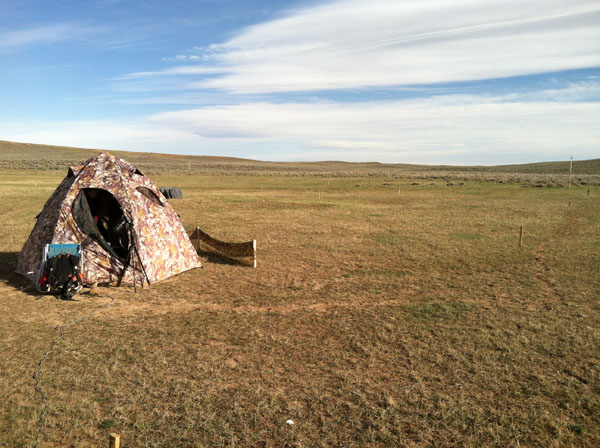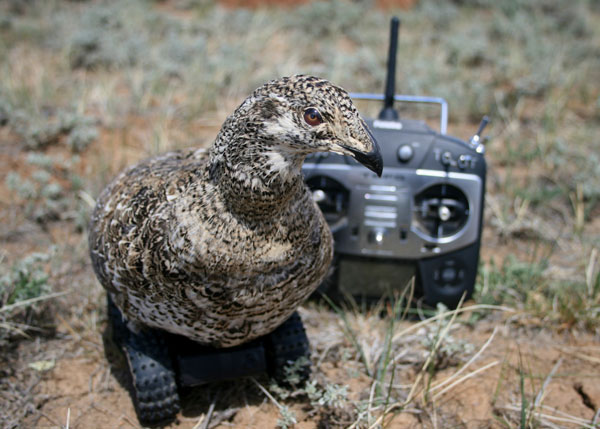In the pre-dawn hours last Friday morning, I had the thrilling experience of joining biologist Dr. Gail Patricelli from UC Davis in a sage grouse blind at a lek in central Wyoming.
On this particular morning, Dr. Patricelli was doing studies using a robotic female grouse (YES, robotic!) to monitor how males respond when a female enters the lek.
Do they move towards her and orient their calls in a certain direction? How persistent are they?
As she described their social structure and behavior, it starts to sound eerily similar to a college fraternity. Some males are clearly more successful than others—attracting and mating with a large cadre of females. This season, the winning male, who the team dubbed “Dick,” was a bit on the rough-and-rude side but won over 60 or so gals (so much for finesse).
I was surprised to learn that of the 40-50 males attending that lek, probably only a small handful would ever “get the girl”. It’s a dog-eat-dog world out there for a male grouse.
From the blind Dr. Patricelli controls the incredibly realistic looking robotic grouse on wheels that she built and affectionately named “Pepa” (there is also a “Salt”).
She has built three so far, each with small improvements from the last. The very first model was maneuvered on train tracks, but Gail found that wheels are sturdier and the robot is less likely to fall over, though getting stuck in the mud is still a problem.
Dr. Patricelli and her Ph.D. student Anna Perry wait until no other females are on the lek so as not to disturb actual breeding events. Then, using a device that looks like a standard remote control for a hobby robot, Anna radios from an overlooking blind to tell Dr. Patricelli to carefully maneuver Pepa out the blind.
This morning she tests male reactions to female behavior by having Pepa either act interested (looking up and around) or uninterested (pecking at the ground) in the “guys” around her.
In addition to recording male responses visually, their calls are being carefully monitored through 16 microphones laid out in a grid pattern across the lek and plugged into digital sound equipment in the blind.

It’s all being recorded to match sound and movement back in the lab. With headphones in the blind we can also “listen in” to the action and this morning I feel like I have a front row seat to Nature’s Sage Grouse Concerto, Opus 17.
Sage grouse leks are painfully quiet places until the males fly in and start calling in the females. Those who have spent any time out in the wilderness of Wyoming sagebrush know what I mean—these are quiet places where wind and occasional meadowlarks are the loudest sounds in spring.
Several studies have measured just how quiet it is in Western sagebrush landscapes and found that background noise (called ‘ambient’ by scientists) is typically about 16 decibels, noticeably quieter than a whisper. It’s key to define ambient levels because policy is often tied to these values and typically allows a certain amount of noise above ambient.
In Wyoming, a protective policy for grouse called the Wyoming Core Area Policy has specified an allowable limit of 10 decibels above ambient. But the team responsible for interpreting the policy is currently determining how ambient will be defined for the policy.
Here is the real intersection of science and policy.
Dr. Patricelli and her team of post-docs and graduate students have done groundbreaking work on noise impacts to sage grouse.
They looked at questions about whether or not disturbances such as oil and gas wells and passing cars affect sage grouse mating behavior and found that sage grouse males do avoid leks with human-caused noise.
As humans increasingly populate remote areas and develop energy, our noise impact isn’t something that most of us think about. Yet studies in Wyoming have documented noise impacts on songbirds and now sage grouse.
It makes sense to me. When our trucks whirr by, a bird’s call to woo his mate just isn’t as loud as it would otherwise be, so they move somewhere else. Fragmentation isn’t just about a physical disturbance footprint, but a sound footprint, as well.
There are many environmental problems that are incredibly complex. One researcher at recent Nature Conservancy science conference described those as “wicked problems.”
Here’s what’s intriguing about the noise problem to me. It doesn’t seem like a wicked problem. To the contrary, it seems like an entirely solvable problem—with engineering solutions like mufflers or insulation.
Or, as Dr. Patricelli suggested with oil and gas operations, maybe shift changes for workers could be at 10:00 am after the males were done calling, rather than at 6:00-8:00 am during peak mating, so that workers were not driving their trucks by the lek at the worst possible time.
With all the problems in the world, can we all at least agree to work together to tackle the solvable ones?
I know some sage grouse in Wyoming that would be thankful.
Video courtesy Dr. Gail Patricelli/UC Davis.




It looks like the grouse are ready to eagerly accept their future robot overlords.
My suggestion for version 4 is some periodic forward oscillation of the body and head during forward movement. Grouse move a bit like pigeons, with periods of horizontal stillness and forward movement.
They give a video credit and video would have been fabulous and easy to produce by just showing us the robo-grouse’s movement abilities – not even in action, which would have rocked, but just in the lab. No such luck – only photos and I clicked them all so I checked. So, what happened to the video that was credited and when will that be posted?
Amy,
I’m not sure why the video disappeared. I fixed it and you should be able to view the video of the grouse robot now. Thanks for reading! Matt
In regards to the last two posts, I agree that it is interesting to see all the various methods of conservation of species, and especially the critical role of scientists in helping us understand thresholds of tolerance to human influence so that we can better plan for and act to conserve species.
Interestingly, researchers using recorded noise seem to find the birds react differently than bird on a lek where traffic noise is rather common. Some of the easiest birds to photograph are those that strut on or near oil field roads.
Awesome post, I love it! It’s true that every country is battling its own war against human influence.
It is intriguing to note the various methodology throughout the world regarding conservation of species. Every country is battling its own war against human influence and economy on various species. As a South African, our foremost challenge is in conservation of Rhino’s, who according to some statistics were down 227 by the beginning of April this year (2014) due to illegal poaching for their horns. As we all attempt to make inroads in this regard, it is encouraging to note that extensive research is continuously being done to preserve the heritage and diversity of different regions, and so preserve the world’s heritage as a whole. Student number: 14017416
The ultimate drone! Love it!